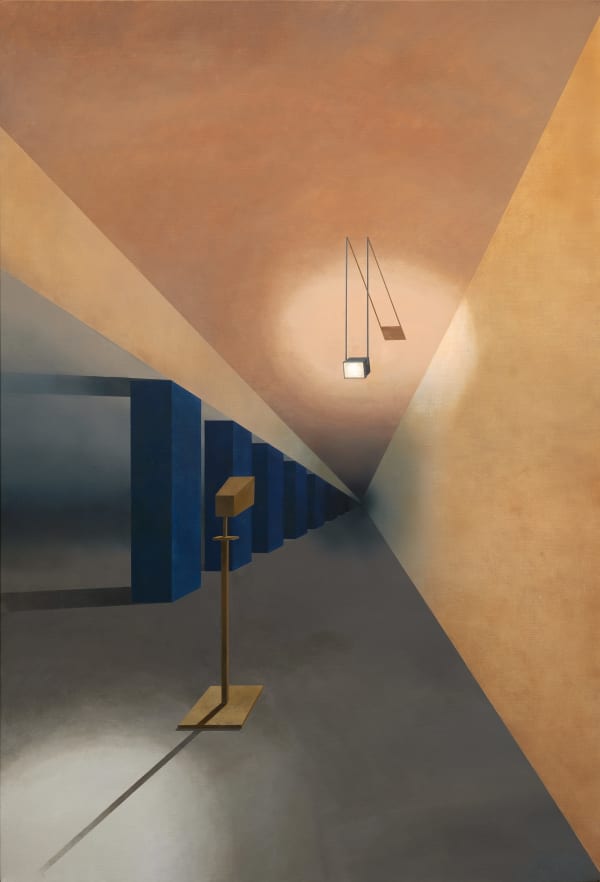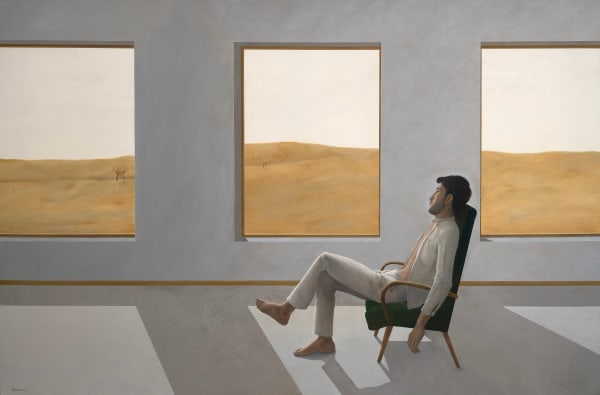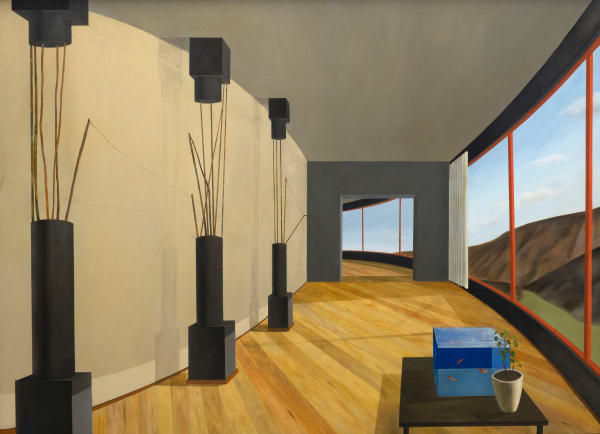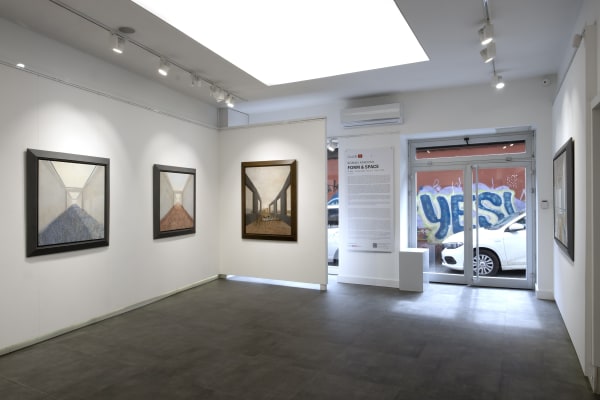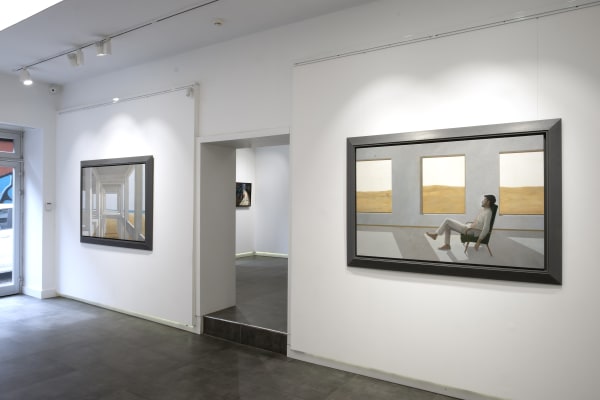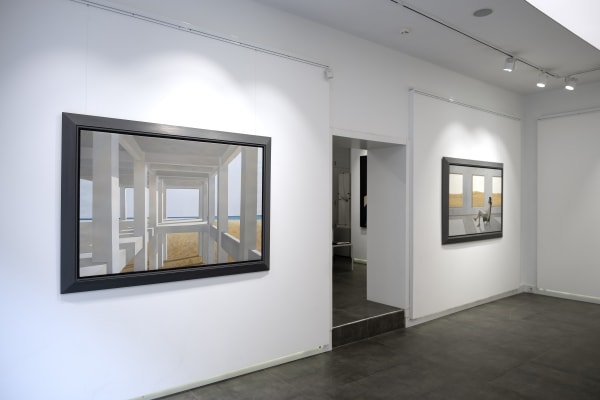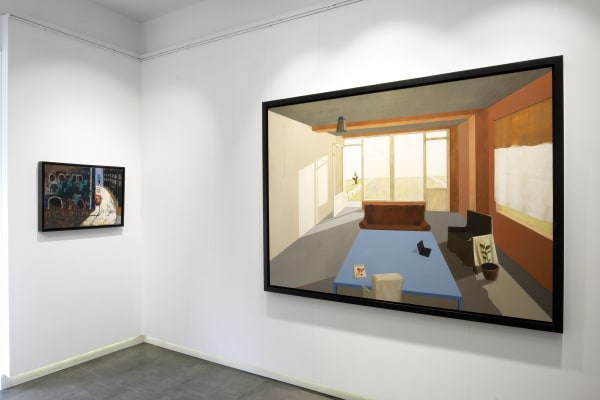Form and Space: Roman Kakoyan
Current exhibition
Overview
Art has long explored the dynamic relationship between space and memory, treating architectural structures not merely as physical frameworks but also as emotional and intellectual domains. Roman Kakoyan’s paintings emerge as a contemporary interpretation of this tradition. In his works, space ceases to be a defined area and instead transforms into an ambiguous, timeless narrative platform open to the viewer. By balancing light and shadow, Kakoyan creates an atmospheric depth in his paintings, drawing the viewer into the space through expansive windows, sharp perspective lines, and architectural elements. However, these are not mere scenes composed of architectural components; rather, they are imbued with a sense of mental emptiness. His composition, devoid of figures, carries traces of the past while evoking an elusive emotional state. To understand Kakoyan’s artistic practice, three key aspects come to the forefront: the conceptual use of space and architecture, the psychological impact of light and shadow, and the evocative atmosphere created by the absence of human figures.
In Kakoyan’s paintings, space is not just a physical construct but a metaphor where the inner and outer worlds converge. Columns, partition walls, and windows do not serve as elements of a realistic architectural depiction but instead act as independent components that construct narratives. Windows, in particular, function as transitional points connecting interior and exterior realms. However, this boundary confronts the viewer with uncertainty, rendering the outside world as an abstract void. This approach imbues his paintings with a sense of solitude and silence, not in a melancholic manner but in a contemplative, serene way. Kakoyan’s spaces become places where human presence is felt yet remains physically absent. One of the most defining aspects that deepens this atmosphere is the artist’s relationship with light and shadow. Kakoyan employs these elements not merely in a formal sense but as metaphors that reveal the soul of the space. Light becomes visible only through shadow, shaping the depth of the environment. In his recent works, the light appears softer, while the shadows emphasize the texture of the space, enhancing its sensory impact.
Similarly, Kakoyan’s figureless compositions redefine the viewer’s engagement with space. The absence of the human figure renders the settings timeless and ambiguous, offering the viewer an open-ended narrative. Having worked in abandoned industrial buildings at different points in his life, Kakoyan has absorbed their silence, which resonates throughout his work. His paintings do not isolate the viewer; instead, they invite them to confront space and expand their perception.
Roman Kakoyan’s first solo exhibition at Galeri 77 is not merely a milestone in his artistic journey but also a reflection of his ongoing explorations. Since 2020, his work has undergone a transformation, moving away from explicit narratives toward an increasingly minimal and abstract approach. Kakoyan’s paintings are scenes that resist time, infused with silence and emptiness, yet profoundly thought-provoking. His works act as windows opening onto a world that is at once familiar and abstract. Each piece leaves behind silent yet resonant echoes, allowing the viewer to construct their own meanings beyond time and space.
Works
-
 Roman Kakoyan, Koridor N1 / Corridor N1, 2023
Roman Kakoyan, Koridor N1 / Corridor N1, 2023 -
 Roman Kakoyan, Oda N4 / Room N4, 2023
Roman Kakoyan, Oda N4 / Room N4, 2023 -
 Roman Kakoyan, Deniz Kıyısında / On the Seashore, 2024
Roman Kakoyan, Deniz Kıyısında / On the Seashore, 2024 -
 Roman Kakoyan, Sarı Tarla / The Yellow Field, 2023
Roman Kakoyan, Sarı Tarla / The Yellow Field, 2023
-
 Roman Kakoyan, İsimsiz / Untitled, 2024
Roman Kakoyan, İsimsiz / Untitled, 2024 -
 Roman Kakoyan, Koridor N2 / Corridor N2, 2023
Roman Kakoyan, Koridor N2 / Corridor N2, 2023 -
 Roman Kakoyan, Koridor N3 / Corridor N3, 2023
Roman Kakoyan, Koridor N3 / Corridor N3, 2023 -
 Roman Kakoyan, Koridor N4 / Corridor N4, 2023
Roman Kakoyan, Koridor N4 / Corridor N4, 2023
Installation Views

